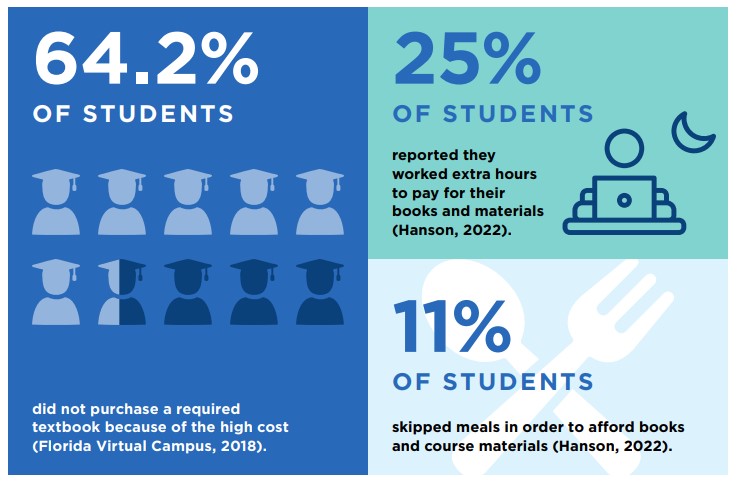William Perrenod
The student debt crisis initially led many faculty and institutions to consider OER—and for good reason. For students, from one semester to the next, the cost of textbooks has been one of the least predictable elements in their budgets when attending college. That cost has been increasing dramatically in recent decades, far outpacing inflation and the price of other consumer goods and services, such as medical care, childcare, and housing. From January 2000 to June 2022, the cost of textbooks increased 162 percent, while the average overall inflation rate rose 74.4 percent.[1]

Image: Watson, C. E., & Rush-Marlowe, R. (2023). Making the case for open educational resources. AAC&U. CC BY-NC-SA
This illustration offers key insights into the ways students respond to challenges created by expensive course materials, including the accommodations they make. [2]

Image: Watson, C. E., & Rush-Marlowe, R. (2023). Making the case for open educational resources. AAC&U. CC BY-NC-SA
Other important findings that may contribute to faculty deciding to adopt OER include:
• the use of OER increases a student’s likelihood of picking that course
• end-of-semester instructor ratings increase after faculty adopt OER, and
• students self-report higher rates of textbook usage in OER-based courses[3]
This image summarizes the results of research conducted on the impact of OER on pass rates at Houston Community College. In this image, OER were found to predict improvements in pass rates for all student groups. This suggests that OER, which are free and open-access educational materials, might have helped students perform better in their courses, possibly by making learning more accessible and affordable. The findings imply that OER could be an effective tool for enhancing student success.

Image: Watson, C. E., & Rush-Marlowe, R. (2023). Making the case for open educational resources. AAC&U. CC BY-NC-SA
Adopting OER is a decision that benefits both faculty and students. Faculty can see higher course enrollment, improved teaching evaluations, and increased student engagement. At the same time, students benefit from free access to educational resources, leading to greater academic success and satisfaction.
Developed by William Perrenod and licensed under CC BY 4.0
- Watson, C. E., & Rush-Marlowe, R. (2023). Making the case for open educational resources. AAC&U. CC BY-NC-SA ↵
- Watson, C. E., & Rush-Marlowe, R. (2023). Making the case for open educational resources. AAC&U. CC BY-NC-SA ↵
- Watson, C. E., & Rush-Marlowe, R. (2023). Making the case for open educational resources. AAC&U. CC BY-NC-SA ↵
